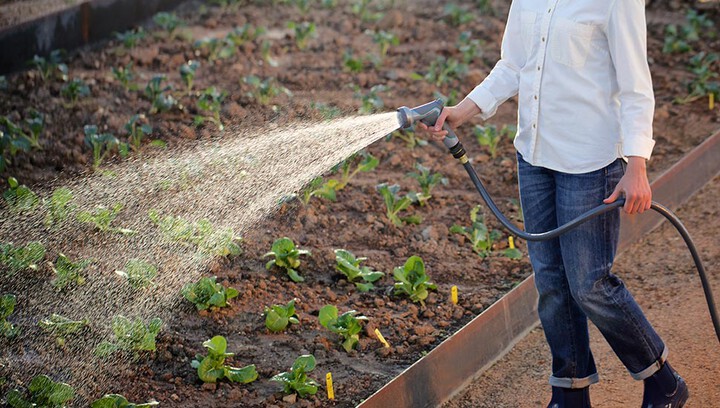
Spring is finally here, and we’re all eager to get out there and plant. But there are some things you should absolutely not do too early in the gardening season if you want your plants to thrive:
1.Don’t Assume that Rain is Enough
New plantings and seedlings require plenty of water—ideally 1-2 shower sessions per day until they’ve settled. Just because your garden is getting a lot of spring rain, don’t assume that relying on Mother Nature is enough.
Head out to your garden each day and shower your plants with the flower setting of your Rear Control Watering Nozzle.
For an easier watering strategy, hook up a programmable timer to an elevated garden sprinkler. Your daily watering will happen without any additional work from you at a set time each day.
2.Don’t Jump the Gun
Everyone wants to be the first to get peas, tomatoes and other vegetables in the ground, but if the ground is too cold, they’ll just sit there. Wait until the soil is at least 40 degrees. How to know? Easy—get a digital meat thermometer with a probe and insert it a couple of inches into the dirt.
Not only should the soil be warm, but it also needs to be the correct consistency. The garden can be too soggy in the early spring as snow melts and rain moves in. What you want is for the soil to be friable—not too wet and not too dry. You can tell by grabbing a fistful and squeezing. If water runs down your arm, you need to wait to plant. If the ball breaks apart in chunks when you open your hand, you’re good to go.
3.Don’t Go Too Far
Established plants benefit from pruning to keep them healthy and in shape. Most perennials can be cut back in the spring or fall, whichever you prefer. But subshrubs are a different story. Subshrubs are perennials that don’t go completely dormant in the winter, only dying at the top.
Some examples are lavender, butterfly bush, chrysanthemum, even some roses. It’s important to wait until these plants start to leaf out before cutting them back, and then to cut above the flush of growth. If you cut back too far, there’s a chance the plant could be damaged enough that it won’t recover.
4.Don’t Keep Them Indoors
Houseplants absolutely belong outside over the summer (in a shady spot, of course). But don’t put them out too early. Keep in mind that most houseplants are tropical and are going to do best in stable temps, plus they don’t like to be shocked.
It’s a good idea to harden them off—and this goes for anything you are moving from inside to out—by increasing their fresh air and sun exposure over the course of a week. (Seedlings you buy at the nursery will already have gone through this.)
5.Don’t Pick the Wrong Sprinkler
Still using the same old sprinkler that you inherited from the previous owner of your home? It’s time to look at what you’re watering and find a sprinkler built for the task. Do you have a lot of vegetables? A soaker hose will deliver water directly into the soil and can easily snake around tight rows of plants.
New trees or shrubs? A bubbler is perfect for directing water to a new plant’s root system while minimizing soil erosion.
For a large garden bed, the most efficient watering tool is an elevated sprinkler. It will shower your flowers with a light rain (and you won’t have to manually spray with your watering nozzle).
With these tips, you can achieve gardening success without hiccups. That’s a Betterday!